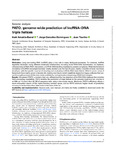Mostrar o rexistro simple do ítem
PATO: genome-wide prediction of lncRNA-DNA triple helices
| dc.contributor.author | Amatria Barral, Iñaki | |
| dc.contributor.author | González-Domínguez, Jorge | |
| dc.contributor.author | Touriño, Juan | |
| dc.date.accessioned | 2023-05-09T18:31:12Z | |
| dc.date.available | 2023-05-09T18:31:12Z | |
| dc.date.issued | 2023-03 | |
| dc.identifier.citation | Iñaki Amatria-Barral, Jorge González-Domínguez, Juan Touriño, PATO: genome-wide prediction of lncRNA–DNA triple helices, Bioinformatics, Volume 39, Issue 3, March 2023, btad134, https://doi.org/10.1093/bioinformatics/btad134 | es_ES |
| dc.identifier.issn | 1367-4811 | |
| dc.identifier.uri | http://hdl.handle.net/2183/33036 | |
| dc.description.abstract | [Abstract]: Motivation: Long non-coding RNA (lncRNA) plays a key role in many biological processes. For instance, lncRNA regulates chromatin using different molecular mechanisms, including direct RNA-DNA hybridization via triplexes, cotranscriptional RNA-RNA interactions, and RNA-DNA binding mediated by protein complexes. While the functional annotation of lncRNA transcripts has been widely studied over the last 20 years, barely a handful of tools have been developed with the specific purpose of detecting and evaluating lncRNA-DNA triple helices. What is worse, some of these tools have nearly grown a decade old, making new triplex-centric pipelines depend on legacy software that cannot thoroughly process all the data made available by next-generation sequencing (NGS) technologies. Results: We present PATO, a modern, fast, and efficient tool for the detection of lncRNA-DNA triplexes that matches NGS processing capabilities. PATO enables the prediction of triple helices at the genome scale and can process in as little as 1 h more than 60 GB of sequence data using a two-socket server. Moreover, PATO's efficiency allows a more exhaustive search of the triplex-forming solution space, and so PATO achieves higher levels of prediction accuracy in far less time than other tools in the state of the art. Availability and implementation: Source code, user manual, and tests are freely available to download under the MIT License at https://github.com/UDC-GAC/pato. | es_ES |
| dc.description.sponsorship | Xunta de Galicia; ED431C 2021/30 | es_ES |
| dc.description.sponsorship | This work was supported by the Ministry of Science and Innovation of Spain [PID2019-104184RB-I00/AEI/10.13039/501100011033]; by the Ministry of Education of Spain [FPU21/00491]; and by Xunta de Galicia [Consolidation Program of Competitive Reference Groups, ref. ED431C 2021/30]. Funding for open access charge was provided by Universidade da Coruña/CISUG. | es_ES |
| dc.description.sponsorship | Funding for open access charge was provided by Universidade da Coruña/CISUG. | es_ES |
| dc.language.iso | eng | es_ES |
| dc.publisher | Oxford University Press | es_ES |
| dc.relation | info:eu-repo/grantAgreement/AEI/Plan Estatal de Investigación Científica y Técnica y de Innovación 2017-2020/PID2019-104184RB-I00/ES/DESAFIOS ACTUALES EN HPC: ARQUITECTURAS, SOFTWARE Y APLICACIONES | es_ES |
| dc.relation.uri | https://doi.org/10.1093/bioinformatics/btad134 | es_ES |
| dc.rights | Atribución 3.0 España | es_ES |
| dc.rights.uri | http://creativecommons.org/licenses/by/3.0/es/ | * |
| dc.subject | DNA / metabolism | es_ES |
| dc.subject | RNA, Long Noncoding* / genetics | es_ES |
| dc.subject | RNA, Long Noncoding* / metabolism | es_ES |
| dc.subject | Software | es_ES |
| dc.title | PATO: genome-wide prediction of lncRNA-DNA triple helices | es_ES |
| dc.type | info:eu-repo/semantics/article | es_ES |
| dc.rights.access | info:eu-repo/semantics/openAccess | es_ES |
| UDC.journalTitle | Bioinformatics | es_ES |
| UDC.volume | 39 | es_ES |
| UDC.issue | 3 | es_ES |
Ficheiros no ítem
Este ítem aparece na(s) seguinte(s) colección(s)
-
GI-GAC - Artigos [190]






